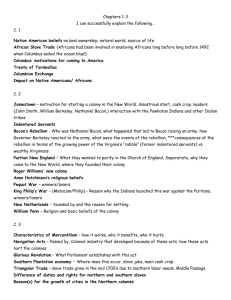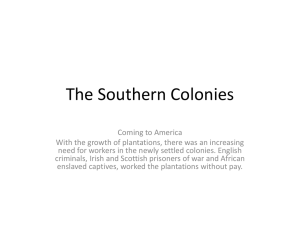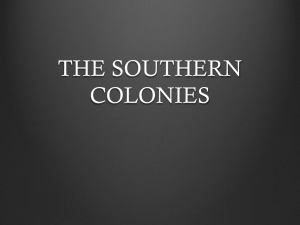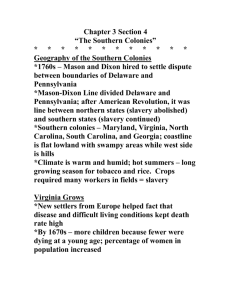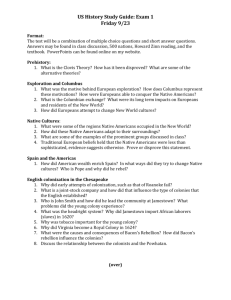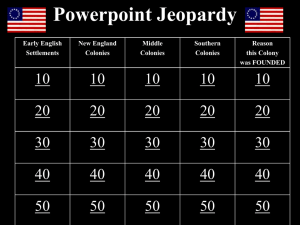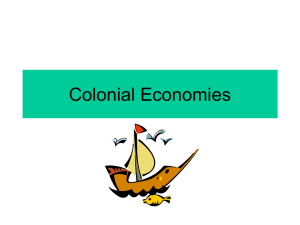2015 Section Three
advertisement
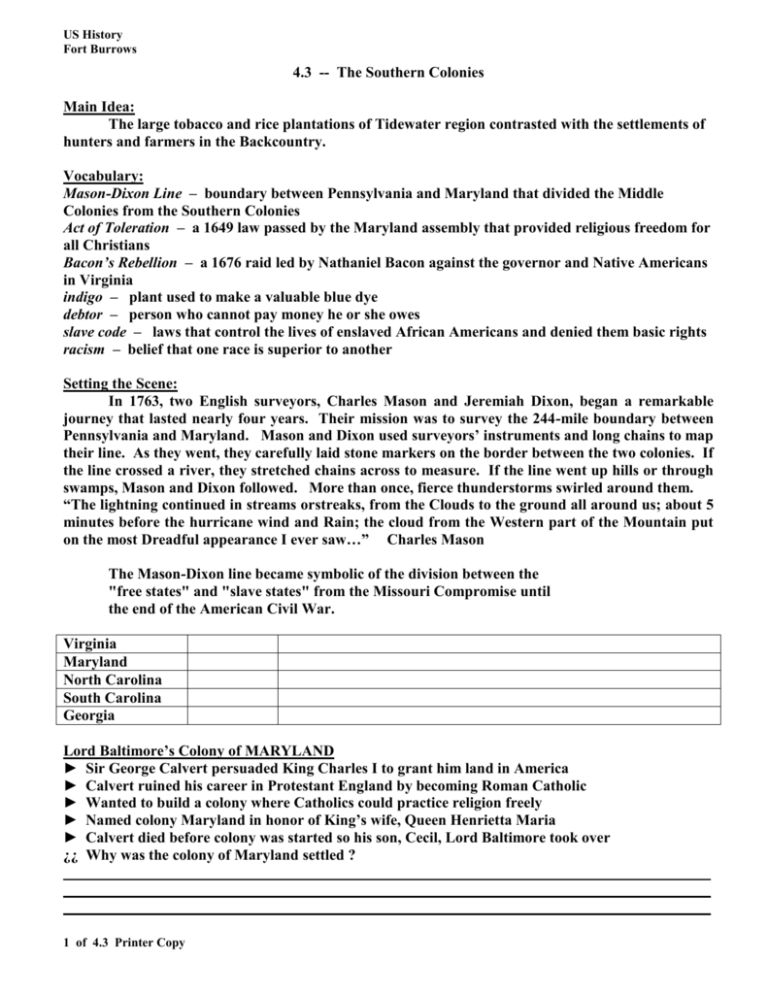
US History Fort Burrows 4.3 -- The Southern Colonies Main Idea: The large tobacco and rice plantations of Tidewater region contrasted with the settlements of hunters and farmers in the Backcountry. Vocabulary: Mason-Dixon Line – boundary between Pennsylvania and Maryland that divided the Middle Colonies from the Southern Colonies Act of Toleration – a 1649 law passed by the Maryland assembly that provided religious freedom for all Christians Bacon’s Rebellion – a 1676 raid led by Nathaniel Bacon against the governor and Native Americans in Virginia indigo – plant used to make a valuable blue dye debtor – person who cannot pay money he or she owes slave code – laws that control the lives of enslaved African Americans and denied them basic rights racism – belief that one race is superior to another Setting the Scene: In 1763, two English surveyors, Charles Mason and Jeremiah Dixon, began a remarkable journey that lasted nearly four years. Their mission was to survey the 244-mile boundary between Pennsylvania and Maryland. Mason and Dixon used surveyors’ instruments and long chains to map their line. As they went, they carefully laid stone markers on the border between the two colonies. If the line crossed a river, they stretched chains across to measure. If the line went up hills or through swamps, Mason and Dixon followed. More than once, fierce thunderstorms swirled around them. “The lightning continued in streams orstreaks, from the Clouds to the ground all around us; about 5 minutes before the hurricane wind and Rain; the cloud from the Western part of the Mountain put on the most Dreadful appearance I ever saw…” Charles Mason The Mason-Dixon line became symbolic of the division between the "free states" and "slave states" from the Missouri Compromise until the end of the American Civil War. Virginia Maryland North Carolina South Carolina Georgia Lord Baltimore’s Colony of MARYLAND ► Sir George Calvert persuaded King Charles I to grant him land in America ► Calvert ruined his career in Protestant England by becoming Roman Catholic ► Wanted to build a colony where Catholics could practice religion freely ► Named colony Maryland in honor of King’s wife, Queen Henrietta Maria ► Calvert died before colony was started so his son, Cecil, Lord Baltimore took over ¿¿ Why was the colony of Maryland settled ? ______________________________________________________________________________________ ______________________________________________________________________________________ ______________________________________________________________________________________ 1 of 4.3 Printer Copy US History Fort Burrows Settling the Colony 200 colonists landed in Chesapeake Bay Bay was full of fish, oysters and crab; hoped to grow tobacco like Virginia Lord Baltimore gave land grants to attract settlers who brought women, children and servants Religious Tolerance Lord Baltimore welcomed Protestants and Catholics Feared Protestants might try to deprive Catholics the right to worship freely Asked assembly to pass Act of Toleration law providing religious freedom to all Christians Bacon’s Rebellion Conflicts arose with Indians over land; many bloody clashes Settlers asked for governor to take action but he refused Nathaniel Bacon organized a settler raid on Indian villages Led followers to Jamestown and burned capital Bacon’s Rebellion did not last long; Bacon died; revolt fell apart Government hanged 23 of Bacon’s followers The CAROLINAS In 1663, 8 English nobles received land grants from King Charles II Settlement took place in the North and the South In the North, settlers were poor tobacco farmers and had small farms Settlement in north became known as North Carolina in 1712 In the South, 8 English nobles set-up a large settlement named Charles Town, known today as Charleston Settlers from the British Caribbean colony in Barbados moved to South Carolina Settlement in South became known as South Carolina in 1719 ¿¿ Why were colonies in the Carolinas established ? ______________________________________________________________________________________ ______________________________________________________________________________________ ______________________________________________________________________________________ Rice of Plantation Slavery In 1685, planters discovered rice grew well in swampy lowlands Carolina rice became a profitable crop traded around the world Learned to raise indigo to make a valuable blue dye Carolina planters needed large numbers of workers to grow rice Tried to enslave Indians but many died of disease or mistreatment Turned to slave labor from Africa brought against their will African Americans outnumbered European Americans 2:1 African Americans made up majority of population in South Carolina GEORGIA Last of England’s 13 colonies James Oglethorpe founded Georgia in 1732 Wanted Georgia to be a place where debtors could make a fresh start Oglethorpe paid for debtors to travel to Georgia 120 colonists built 1st settlement at Savannah, above Savannah River Farms could be no bigger than 500 acres and slavery was forbidden Colony grew slowly so Oglethorpe allowed plantations and slave labor 2 of 4.3 Printer Copy US History Fort Burrows ¿¿ Why was the colony of Georgia founded ? ______________________________________________________________________________________ ______________________________________________________________________________________ ______________________________________________________________________________________ Two Ways of Life Tidewater Plantations Southern colonies enjoyed warmer weather and longer growing season Virginia, Maryland and parts of North Carolina – major tobacco growers South Carolina and Georgia – rice and indigo More profitable to raise tobacco on LARGE plantations 20 to 100 slaves did most of the work Planters settled along rivers and creeks offering rich farmland Tidewater plantations had their own docks to move goods to markets Small percentage of white southerners owned large plantations The Backcountry South West of Tidewater, life was VERY different Backcountry was located at base of Appalachians; rolling hills; thick forests Backcountry settlers treated one another as equals Smaller farms and fields of tobacco and crops Self-sufficient for family’s food; surplus were sold at local markets Very few slaves in Backcountry Hardships of Backcountry life brought settlers closer together ¿¿ Write in your answers as you COMPARE the physical and human characteristics of the tidewater and backcountry regions of the South. Tidewater Region physical characteristics human characteristics Backcountry Region 1. 1. 2. 2. 3 3. 1. 1. 2. 2. 3. 3. Growth of Slavery and the Slave Trade Look on page 118. Read the two paragraphs under Growth of Slavery and the Slave Trade to answer: ¿¿ Why did the slave trade grow in the Southern Colonies ? ______________________________________________________________________________________ ______________________________________________________________________________________ ______________________________________________________________________________________ Slavery in Africa Slavery had been a part of the social/economic system since ancient times In Africa, traders transported and sold slaves as laborers Europeans offered guns and other goods in exchange for slaves Africans were loaded on European ships headed for America 3 of 4.3 Printer Copy US History Fort Burrows The Middle Passage Name given by English to passage of slave ships across Atlantic Ocean Slaves were chained together and packed like sardines below deck Some resisted but only a few escaped; some jumped overboard 10 to 20% on board died during voyage of disease or mistreatment Lasted 400 years; 2-3 million Africans died Limiting Rights As slavery increased, colonists passed laws that set out rules for slaves’ behavior and denied their basic rights Slave codes treated enslaved Africans not as human beings but as property English colonists believed black Africans were inferior to white Europeans Racism was rampant Quakers in Germantown, PA was first group to call for an end to slavery ¿¿ What were the Slave codes ? ______________________________________________________________________________________ ______________________________________________________________________________________ ______________________________________________________________________________________ 1. Why was Maryland important to Roman Catholics ? ______________________________________________________________________________________ ______________________________________________________________________________________ ______________________________________________________________________________________ 2. Who found the Carolinas ? ______________________________________________________________________________________ ______________________________________________________________________________________ ______________________________________________________________________________________ 3. Why was Georgia founded ? ______________________________________________________________________________________ ______________________________________________________________________________________ ______________________________________________________________________________________ 4. What two ways of life developed in the Southern Colonies ? ______________________________________________________________________________________ ______________________________________________________________________________________ ______________________________________________________________________________________ 5. Why did the slave trade grow in the 1700s ? ______________________________________________________________________________________ ______________________________________________________________________________________ ______________________________________________________________________________________ 4 of 4.3 Printer Copy
